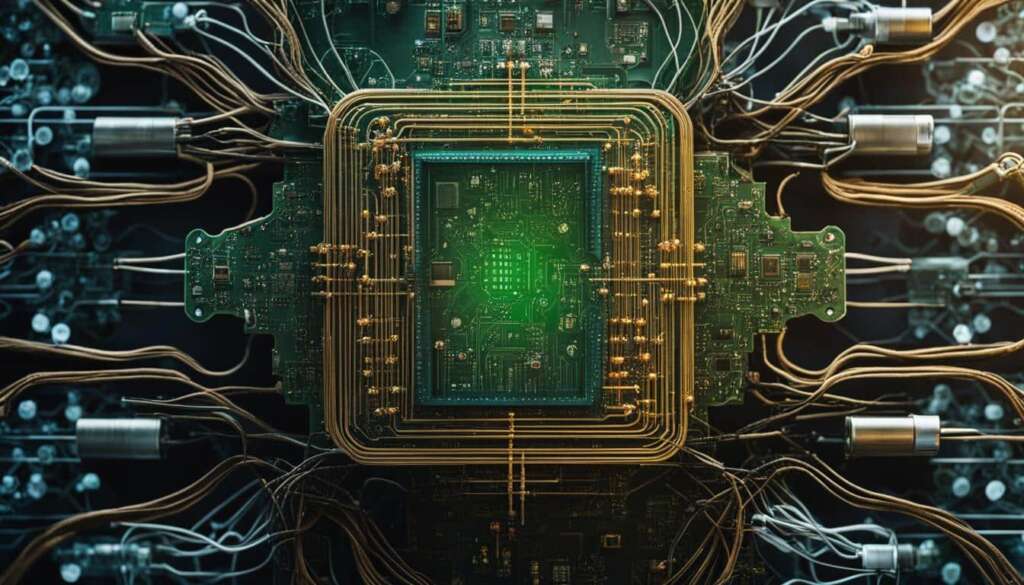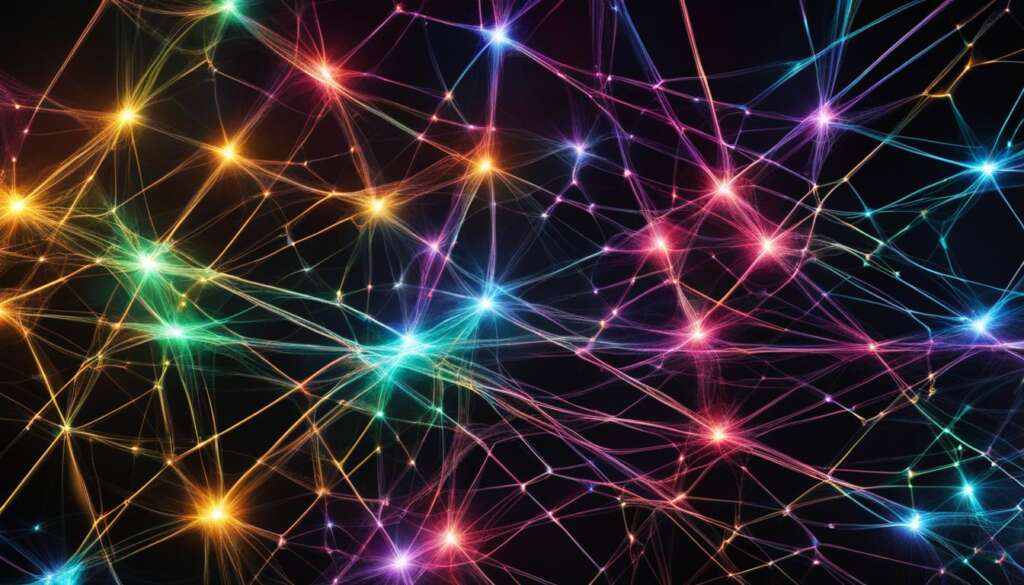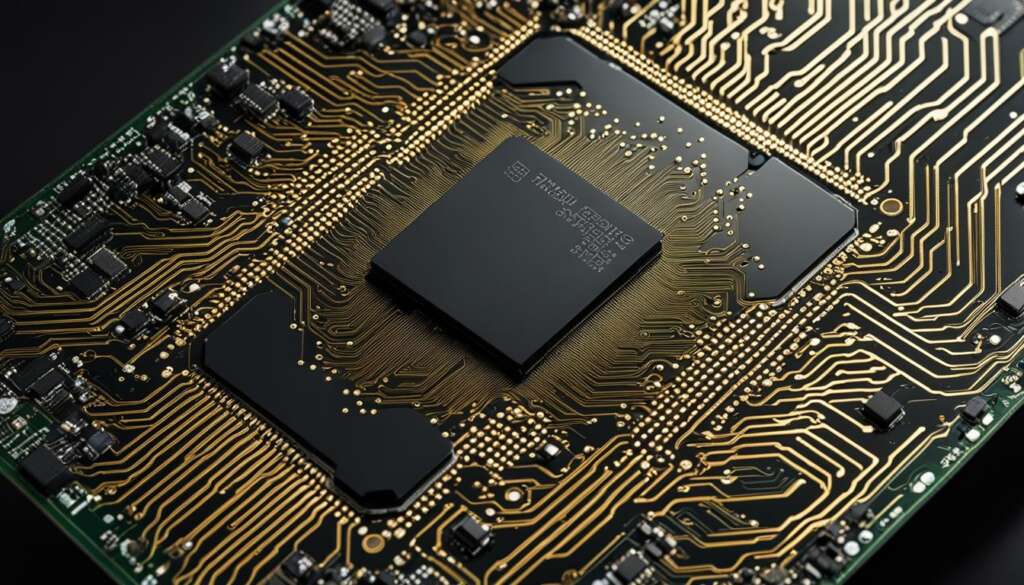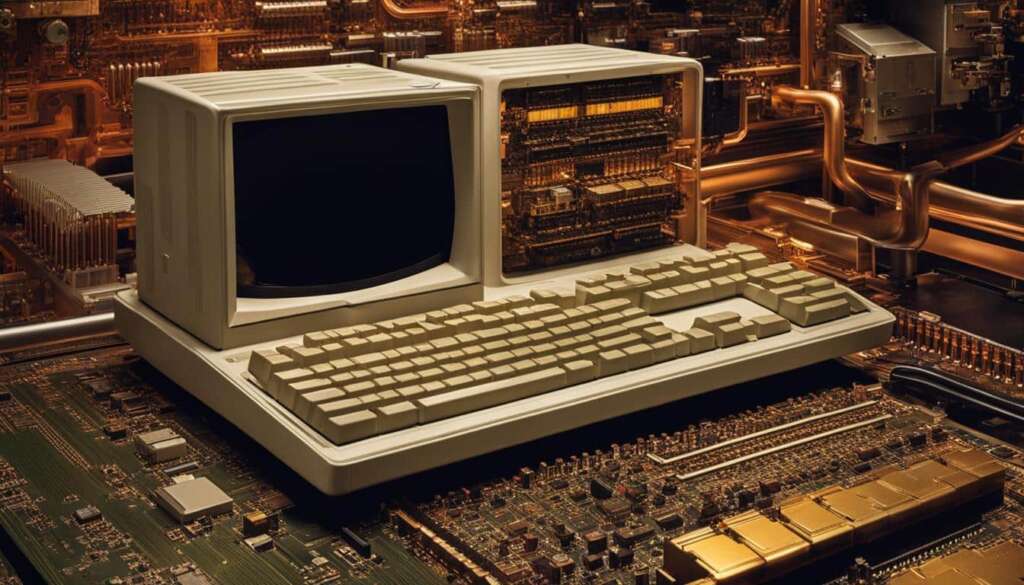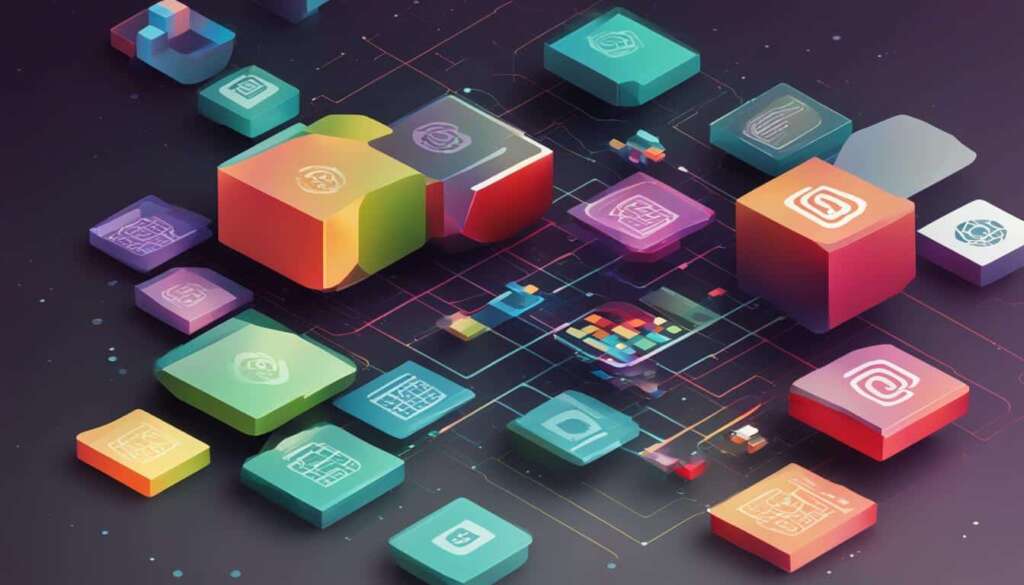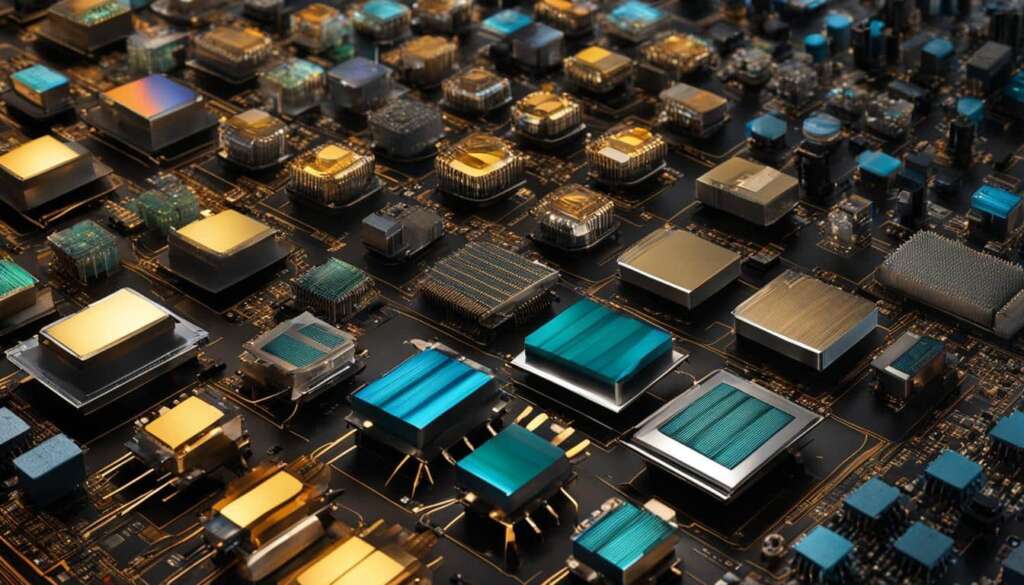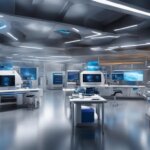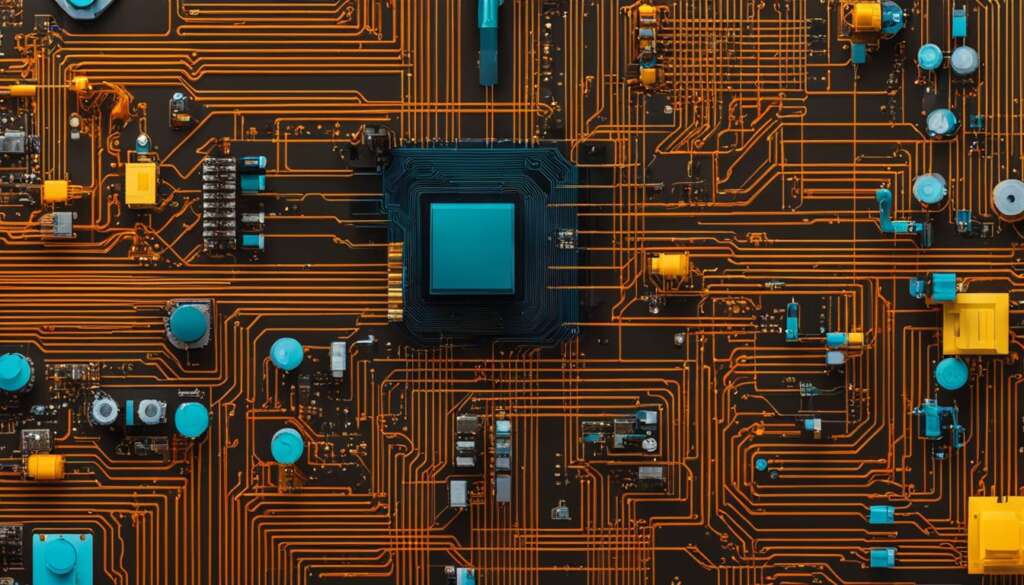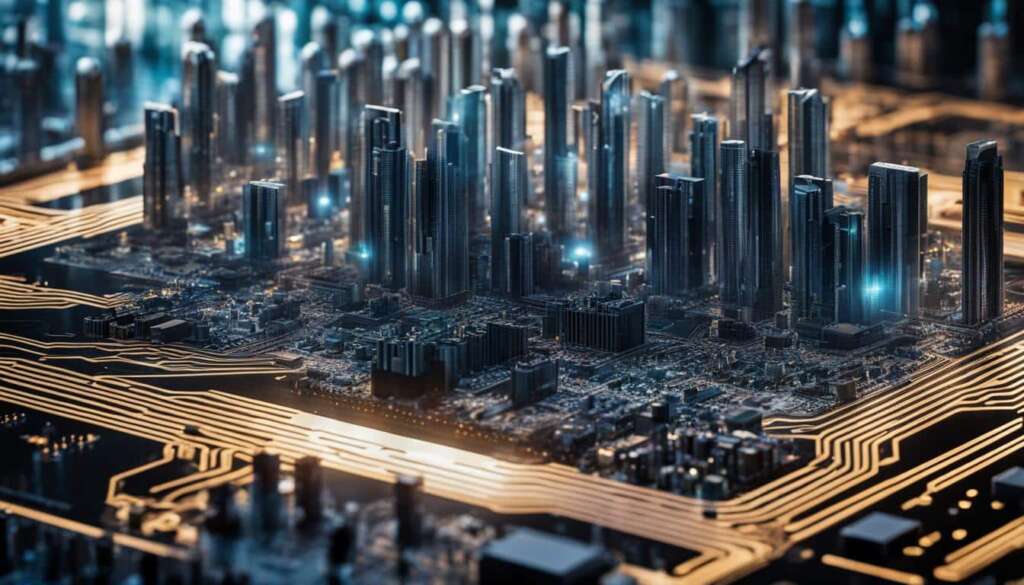Table of Contents
Welcome to an exciting new era in computing – the world of biocomputing and organic processors. In this rapidly evolving field, scientists are developing revolutionary processors made from living cells, aiming to harness the power of biological systems in computational tasks. Biocomputing holds immense potential for transforming industries such as bioinformatics and computational biology, opening up a whole new realm of possibilities.
Biocomputing processors are groundbreaking devices that utilize chemical inputs and biologically derived molecules instead of traditional electrical components. By leveraging the unique capabilities of living cells, these organic processors offer a fresh approach to data processing and analysis.
In the field of bioinformatics, biocomputing processors have the potential to revolutionize data analysis, enabling faster and more efficient computations. Computational biologists can benefit from the ability of these processors to handle complex biological data and simulate intricate biological processes.
As research in biocomputing progresses, we can expect to witness advancements in computational biology. Biocomputing processors may lead to breakthroughs in understanding biological systems, unraveling the mysteries of life, and accelerating scientific discoveries.
The future of biocomputing and organic processors is bright, with exciting possibilities awaiting us. Stay tuned as we explore the fascinating world of biocomputing and its impact on our technological landscape.
What are Biological Computers?
Biological computers are ground-breaking computational devices that utilize proteins and DNA as their building blocks. Unlike traditional electronic computers, which rely on electrical components, biological computers process data through chemical reactions and the manipulation of biological molecules. The potential of these organic processors is immense, with researchers already achieving significant milestones in their development, such as the completion of logic gates with biological computers.
By harnessing the computational capabilities of proteins and DNA, biological computers have the potential to perform complex computational tasks in the future. While they may currently be less sophisticated than modern computers, ongoing research and advancements in biocomputing are paving the way for exciting possibilities in various industries.
“Biological computers process data through chemical reactions and the manipulation of biological molecules.”
Computational Capabilities
Biological computers utilize intricate networks of proteins and DNA to carry out computational tasks. Proteins are responsible for a wide range of functions within living organisms, and researchers have found ways to manipulate their behavior to perform specific computational operations. DNA, on the other hand, serves as the information storage and processing unit in biological computers. By leveraging the unique properties of proteins and DNA, researchers are exploring ways to enhance the computational capabilities of biological computers.
“Proteins and DNA serve as the building blocks for biological computers, enabling them to carry out computational tasks.”
Table: Comparative Features of Biological and Electronic Computers
| Feature | Biological Computers | Electronic Computers |
|---|---|---|
| Components | Proteins and DNA | Electrical circuits and transistors |
| Processing Method | Chemical reactions | Electric signals |
| Data Storage | DNA | Hard drives and memory chips |
| Computational Speed | Relatively slower | Relatively faster |
| Scalability | Potentially highly scalable | Dependent on circuitry |
| Energy Efficiency | Highly energy efficient | Varies depending on design |
As the table illustrates, biological computers exhibit unique characteristics compared to their electronic counterparts. While they may currently have limitations in terms of computational speed, the potential scalability and energy efficiency of biological computers make them an area of great interest for future advancements in computing technology.
The Potential of Biocomputers
Biocomputers offer immense potential in various industries, thanks to their cost-effectiveness, reliability, and programmable cells. These unique characteristics make biocomputers a promising technology for a wide range of biomedical applications.
One of the key advantages of biocomputers is their cost-effectiveness. Once a single biological cell is programmed, it can be replicated at a low cost, potentially leading to mass production of biocomputers. This cost-effectiveness opens up avenues for widespread adoption in industries that require large-scale computational power.
Another significant advantage of biocomputers is their reliability. Unlike traditional electronic computers, where the failure of a single component can render the entire system useless, biocomputers can still function even if some cells are damaged or die. This resiliency makes biocomputers highly reliable, ensuring uninterrupted and efficient performance in critical applications.
Furthermore, the programmability of cells in biocomputers allows for the synthesis of any biological chemical once they have been programmed. This programmability enables the development of various biomedical applications, such as targeted drug delivery or disease detection. By harnessing the power of programmable cells, biocomputers have the potential to revolutionize the field of medicine and healthcare.
Table: Potential Biomedical Applications of Biocomputers
| Application | Description |
|---|---|
| Targeted Drug Delivery | Biocomputers can be programmed to synthesize and release drugs at specific target sites in the body, improving the efficacy and minimizing side effects. |
| Disease Detection | Biocomputers can be designed to detect specific biomarkers or genetic sequences associated with diseases, enabling early and accurate diagnosis. |
| Biological Sensors | Biocomputers can be used to develop highly sensitive and specific biosensors for detecting environmental pollutants, toxins, or pathogens. |
| Tissue Engineering | Biocomputers can aid in the precise manipulation of cellular behavior, facilitating the growth of artificial tissues and organs for transplantation. |
In conclusion, biocomputers present a world of possibilities in terms of cost-effective computing, reliability, and programmable cells. As research and development in this field continue to progress, we can anticipate groundbreaking advancements that will shape the future of biomedicine and revolutionize various industries.
Biological Computing Challenges at the Intersection of Biology and Computer Science
Biocomputing is a complex field that presents unique challenges due to its interdisciplinary nature, sitting at the intersection of biology and computer science. While biologists work towards reverse engineering existing biological systems, biocomputing requires forward engineering biology to create computational devices. This integration of disciplines can lead to unpredictable reactions in the wet lab environment, making progress in biocomputing an intricate and fascinating endeavor.
The collaboration between biologists and computer scientists in the field of biocomputing sparks innovative ideas and approaches. However, it also presents challenges that need to be overcome. The inherent unpredictability of living organisms introduces a level of uncertainty in the behavior of biological computers, making it difficult to control and optimize their performance. External factors, such as environmental conditions and timing, can influence the reactions of biological systems, further complicating the development and implementation of biocomputing technologies.
Another challenge in biocomputing lies in the vast differences between the biology and computer science domains. While computer algorithms are designed to follow defined rules and produce consistent outputs, biological systems can exhibit varying behaviors, influenced by factors such as gene expression and cellular interactions. This fundamental difference requires researchers to develop new methods and models to bridge the gap between biology and computer science, ensuring the successful integration of these disciplines in biocomputing.
The Unpredictability of Biological Reactions
Biocomputing poses unique challenges as it combines the complexities of biology with the precision of computer science. The unpredictability of biological reactions in the wet lab environment adds an additional layer of complexity, requiring researchers to carefully navigate through uncharted territories. However, despite the challenges, the potential benefits of biocomputing make it a field worth exploring.
| Challenges of Biocomputing | Solutions |
|---|---|
| Unpredictable reactions in biological environments | Developing robust models and algorithms that can account for variability and uncertainties in biological systems. |
| Integration of biology and computer science | Promoting interdisciplinary collaboration and knowledge exchange between biologists and computer scientists. |
| Controlling and optimizing the performance of biological computers | Designing feedback mechanisms and control systems to enhance the reliability and efficiency of biocomputing technologies. |
The challenges in biocomputing require innovative solutions that leverage the strengths of both biology and computer science. By addressing these challenges head-on, researchers can unlock the full potential of biocomputing and pave the way for groundbreaking advancements in computing and biological sciences.
Current Applications of Biological Computing
“Biocomputing is not just a theoretical concept anymore. It has already found practical applications in various industries.”
Companies like Synthego are at the forefront of utilizing biocomputing principles in the field of gene editing. Through the development of customized CRISPR kits, Synthego has significantly reduced the time required for scientists to perform gene edits. This breakthrough in gene editing technology has immense potential for advancements in medical research and genetic therapies.
Another notable player in the field is Microsoft, which has embarked on the Station B project in collaboration with academic institutions and biotech companies. This project aims to leverage the power of biological computing for biomedical data analysis. By harnessing the computational capabilities of biological systems, Microsoft envisions a future where complex data analysis in the biomedical field becomes more efficient and effective.
The application of biocomputing extends beyond gene editing and data analysis. It has the potential to revolutionize various industries, from agriculture to environmental monitoring. For example, researchers are exploring the use of biological computing in developing sustainable agricultural practices by leveraging the computation capabilities of living cells to optimize crop growth and improve yield.
| Company | Application |
|---|---|
| Synthego | Gene editing |
| Microsoft | Biomedical data analysis |
| Various researchers | Sustainable agriculture |
The current applications of biocomputing exemplify the transformative potential of this emerging field. As more researchers and companies delve into the possibilities of biological computing, we can expect to see even more groundbreaking applications that redefine how we solve complex problems across various domains.
Brain Organoids and Organoid Intelligence
In recent years, the field of bioengineering has witnessed significant advancements in the development of brain organoids. These 3D cultures of human brain cells have the remarkable ability to mimic certain aspects of brain function, making them valuable tools for neuroscience research. By bioengineering brain organoids, scientists are unlocking the potential of organoid intelligence (OI) – a multidisciplinary field that aims to harness the computational capabilities of these artificial brain tissues.
Organoid intelligence holds great promise in advancing our understanding of brain development, learning, and memory. Researchers are working towards developing brain organoids that can perform complex computations, paving the way for breakthroughs in the field of neuroscience. These artificial neuronal networks have the potential to revolutionize our understanding of the brain and its intricacies.
“Brain organoids offer an unprecedented opportunity to explore the emergent behaviors and computational capacities of brain-like tissues in the lab,” says Dr. Anna Smith, a leading neuroscientist in the field of organoid intelligence. “By studying the activity and interactions of artificial neuronal networks, we can gain valuable insights into the underlying mechanisms of human cognition.”
Current Applications of Brain Organoids
Brain organoids are already making an impact in various areas of research. In the field of neurodevelopmental disorders, these mini-brains provide a unique platform to study conditions such as autism and schizophrenia, offering insights into abnormal brain development. In drug discovery, organoids can be used to test the efficacy and safety of potential therapeutics, reducing the need for animal testing and expediting the drug development process. Furthermore, brain organoids are helping researchers unravel the complexities of neurodegenerative diseases like Alzheimer’s and Parkinson’s, providing invaluable data for the development of new treatment strategies.
| Application | Benefits |
|---|---|
| Neurodevelopmental disorder research | Insights into abnormal brain development |
| Drug discovery | Evaluating efficacy and safety of potential therapeutics |
| Neurodegenerative disease research | Understanding the underlying mechanisms and developing new treatments |

The advancements in brain organoids and the emerging field of organoid intelligence present exciting opportunities for neuroscience. As our understanding of these bioengineered brain tissues continues to expand, we can expect further breakthroughs in the exploration of brain function, neurodevelopmental disorders, and neurodegenerative diseases. The future of neuroscience research is closely intertwined with the possibilities offered by brain organoids and organoid intelligence.
The Future Possibilities of Biological Computing
Biocomputers hold immense potential for the future of computing, offering capabilities that can revolutionize various industries and address significant challenges. One of the key advantages of biocomputers is their ability to enable faster decision-making. By leveraging the parallel processing capabilities of biological systems, biocomputers can quickly analyze vast amounts of data and provide real-time insights. This speed and efficiency make them particularly well-suited for applications that require rapid decision-making, such as financial modeling or complex simulations.
Another exciting aspect of biocomputers is their potential for continuous learning. Unlike traditional computers, which require explicit programming for each task, biocomputers can adapt and improve their performance over time. By utilizing the inherent learning capabilities of living cells, biocomputers can refine their algorithms and optimize their operations based on experience and feedback. This continuous learning ability opens up new possibilities for developing intelligent systems that can continually adapt and improve, making them ideal for tasks that involve complex and evolving environments.
Energy efficiency is another significant advantage of biocomputers. Traditional electronic computers consume substantial amounts of energy and generate heat, contributing to environmental concerns and increasing operational costs. In contrast, biocomputers leverage the natural energy efficiency of biological processes, requiring minimal energy inputs to perform computations. This energy-saving characteristic not only reduces the environmental impact but also offers cost savings in large-scale computing applications.
Applications in Neurodegenerative Diseases
One area where biocomputers hold great promise is in the field of neurodegenerative diseases. Conditions like dementia and Alzheimer’s disease pose significant challenges for diagnosis and treatment due to their complex nature. Biocomputers offer an innovative approach to understanding these conditions by combining computational power with insights from neurochemistry. By integrating data from genetic profiles, patient records, and environmental factors, biocomputers can help identify patterns and underlying causes of neurodegenerative diseases. This newfound knowledge can fuel the development of targeted treatments and interventions, potentially leading to breakthroughs in managing and preventing these devastating conditions.
The future of biological computing is bright, with the potential to revolutionize decision-making, continuous learning, energy efficiency, and advancements in tackling neurodegenerative diseases. As research progresses and more innovations emerge, biocomputers will play an increasingly vital role in shaping the future of computing and transforming various industries.
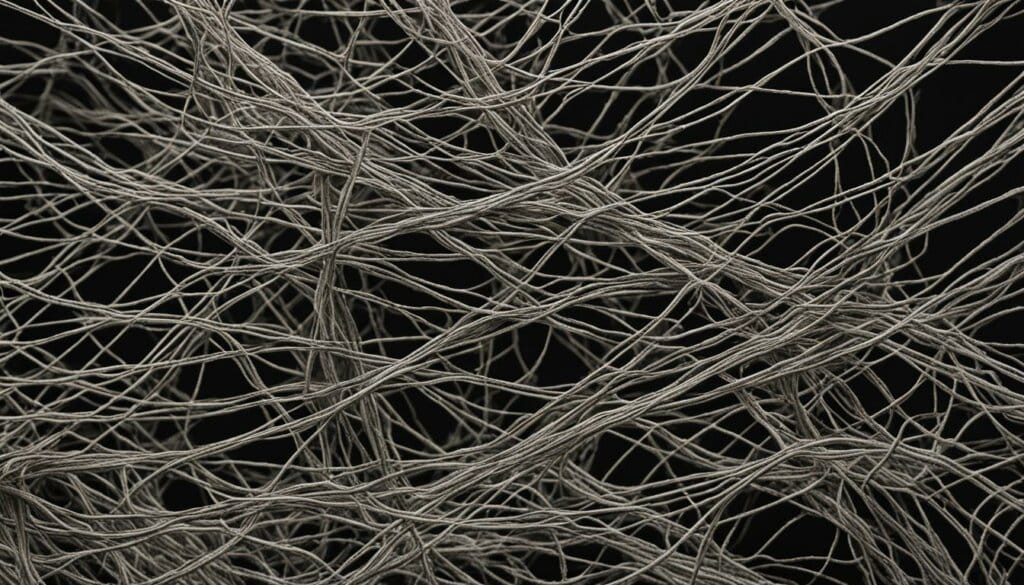
Breakthroughs in Organic Computing
Recent breakthroughs in the field of organic computing have brought us closer to practical applications that could revolutionize the future of computing. Scientists and researchers have made significant strides in developing innovative technologies, such as virus-based memory and reprogrammable DNA computers, that offer exciting possibilities for the field of biocomputing.
One remarkable breakthrough in organic computing involves the use of viruses to create faster computer memory. By harnessing the unique properties of viruses, researchers have found a way to enhance data transfer and storage capabilities. This virus-based memory technology shows promise in overcoming current limitations and could lead to faster and more efficient computing systems.
Another groundbreaking achievement in organic computing is the development of reprogrammable DNA computers. These computers can run multiple algorithms, offering flexibility in computing tasks. By leveraging the programmability of DNA, researchers can design computers that adapt to different computational requirements, leading to more versatile and efficient computing systems.
The advancements in organic computing open up a world of possibilities for the future. With virus-based memory and reprogrammable DNA computers, the field of biocomputing is poised for significant advancements in data processing, storage, and computation. These breakthroughs pave the way for the development of practical organic computers with diverse applications, from healthcare and biotechnology to artificial intelligence and beyond.
Table: Breakthroughs in Organic Computing
| Breakthrough | Description |
|---|---|
| Virus-Based Memory | Using viruses to create faster computer memory and enhance data transfer and storage capabilities. |
| Reprogrammable DNA Computers | Developing computers that can run multiple algorithms, offering flexibility in computing tasks. |
Conclusion
Biocomputing processors represent the future of computing. With their unique capabilities and potential for advancements in various fields, including bioinformatics, computational biology, and neurosciences, biocomputing processors hold the promise of unlocking new possibilities in data processing and analysis.
As technology continues to evolve, the development of organic processors will revolutionize the way we approach computing. These processors, made from living cells and utilizing chemical reactions and biologically derived molecules, have the potential to surpass traditional electronic computers in terms of cost-effectiveness, reliability, and programmability.
The future of computing lies in the realm of biocomputing. The integration of biology and computer science opens up endless possibilities for faster decision-making, continuous learning, and greater energy and data efficiency. Furthermore, biocomputing research could lead to breakthroughs in understanding and treating neurodegenerative diseases.
As researchers and scientists continue to explore and innovate in the field of biocomputing, we can look forward to a future where organic processors revolutionize industries and transform the way we process and analyze data. The future is bright for biocomputing and the exciting possibilities it brings.
FAQ
What are biocomputers?
Biocomputers are computational devices made from living cells, using proteins and DNA as their building blocks. They process data using chemical reactions and molecules instead of traditional electronic components.
What are the advantages of biocomputers?
Biocomputers offer cost-effectiveness, as a single programmed cell can be replicated at a low cost. They are also more reliable than traditional computers as individual cells can still function even if some cells are damaged. Programmable cells can synthesize any biological chemical once programmed, enabling various biomedical applications.
What are the challenges of biocomputing?
Biocomputing lies at the intersection of biology and computer science, which poses unique challenges. Forward engineering biology for computational devices can result in unpredictable reactions in biological environments. External factors like environmental conditions and timing can also influence the behavior of biological computers.
What are the current applications of biological computing?
Companies like Synthego are using biocomputing principles to develop customized CRISPR kits for gene editing. Microsoft’s Station B project aims to use biological computing for biomedical data analysis. These examples highlight the potential of biological computing in gene therapy, biomedical research, and more.
What is organoid intelligence?
Organoid intelligence is a multidisciplinary field that aims to harness the computational potential of brain organoids. Brain organoids are 3D cultures of human brain cells that mimic aspects of brain function. Scientists are working to develop brain organoids that can perform complex computations, leading to advancements in neuroscience and our understanding of the brain.
What are the future possibilities of biological computing?
Biocomputers have the potential to enable faster decision-making, continuous learning, and greater energy and data efficiency compared to traditional computers. Additionally, research in biocomputing could help unravel the mysteries of neurodegenerative diseases and lead to the development of new treatments.
What are the recent breakthroughs in organic computing?
Researchers have developed a method using a virus to create faster computer memory, potentially overcoming current limitations in data transfer and storage. Reprogrammable DNA computers that can run multiple algorithms have also been achieved, offering flexibility in computing tasks.
What is the future of biocomputing and organic processors?
Biocomputing processors hold the promise of unlocking new possibilities in data processing and analysis. With their unique capabilities and potential advancements, they have the potential to revolutionize fields such as bioinformatics, computational biology, and neurosciences.

